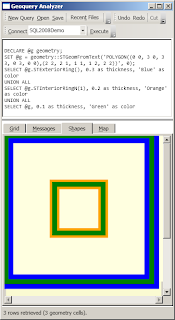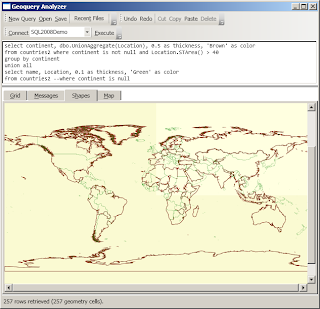DECLARE @g geometry;
SET @g = geometry::STGeomFromText('POLYGON((0 0, 3 0, 3 3, 0 3, 0 0),(2 2, 2 1, 1 1, 1 2, 2 2))', 0);
SELECT @g.STExteriorRing().ToString();which returns
LINESTRING (0 0, 3 0, 3 3, 0 0, 0 0) Here it is visually -- the Green line is the original geometry (one square inside another), the thicker Blue line shows that STExteriorRing and the Orange line shows STInteriorRing(1):
Here it is visually -- the Green line is the original geometry (one square inside another), the thicker Blue line shows that STExteriorRing and the Orange line shows STInteriorRing(1):DECLARE @g geometry;
SET @g = geometry::STGeomFromText('POLYGON((0 0, 3 0, 3 3, 0 3, 0 0),(2 2, 2 1, 1 1, 1 2, 2 2))', 0);
SELECT @g.STExteriorRing(), 0.3 as thickness, 'Blue' as color
UNION ALL
SELECT @g.STInteriorRingN(1), 0.2 as thickness, 'Orange' as color
UNION ALL
SELECT @g, 0.1 as thickness, 'Green' as colorInterestingly, this query exposed a bug in Geoquery where the Exterior and Interior rings were being 'joined' (ie there was no "pen up" occuring as the shapes were generated) -- causing the dodgy looking lines on the world map in the last post. Here's the "fixed" map drawing...

No comments:
Post a Comment
Note: only a member of this blog may post a comment.